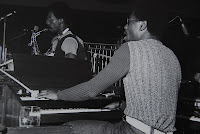 Year of Release: 2007
Year of Release: 2007Label: Plastic Strip
Genre: Jazz ---> Funk ---> Soul ---> Gospel
Music: 4.5
Sound: 4
Format Reviewed:LPGood evening ladies and gentlemen to Club7 - bringing you the finest in Jazz, Funk and Soul in all of Norway and indeed Scandinavia. Tonight we have something very special for you...Webster Lewis and the Post-pop, space-rock, be-bop, gospel tabernacle chorus and orchestra Baby!!
An audacious name to live up to, but it very appropriately describes the fusing of genres and sound this wonderful album brings.
Also known as the more conventional Webster Lewis Quintet, they recorded this album over a Friday and Saturday night in a club in Oslo, Norway 1971. It was mixed and cut over the next few days by Webster Lewis and Jan-Erik before the band left on the Tuesday.
The result is nothing short of spectacular. Every track on the record (although I have to go buy the CD now as I recently found out there's more material on it) is jazz of the highest caliber. But it's only the first track - Do You Believe alt. Version that lives up to their name - Webster Lewis and the Post-pop, space-rock, be-bop, gospel tabernacle chorus and ochestrata Baby!!
Do You Believe alt. Version moves and sounds like nothing I've heard; It opens with the soft organ stabs of Webster's Hammond, followed promptly by the beat of the incomparable Jimmy Hopps. Out from the darkness comes the ever-soulful voice of Judd Watkins crooning with the question "Do You Believe?". It's only 1 minute into a 17 minute track and Brother Watkins, I believe! It's essentially as Gospel track, rooted in Jazz, but is Jazz allowed to be so damn funky? The quintet is rounded out by two saxophonists, Stan Strickland on Tenor and Bobby Green on Alto. This track builds and builds, featuring great solos by all but is ushered through the highs and lows by Judd Watkins. However, the highlight is undoubtedly Jimmy Hopps on drums and percussion, indeed for me, he is the standout on the entire LP with his beats ringing out so clearly, with both delicacy and strength.
Dudes - every one of them
Before this album, I didn't know much about any of the band members and it would appear that time as a quintet was brief although bright, particularly in the Scandinavian Jazz scene. They were invited to play at the Molde and Kongsberg Jazz Festival in 1972 where they outshone amongst others, Chick Corea and the Weather Report; after listening to the opening track, I'm not at all surprised. What does surprise me, is that individuals of such immense talent can be relatively unknown by the public (although they are highly respected in the scene). Check out Jimmy Hopps profile at Jazz.com - he's not your ordinary drummer and sheds some light on the brilliance of his breaks; find me a drummer that has studied classical piano, clarinet, Negro Spiritual music, Chinese oriental medicine and is invited to play in apartheid South Africa, Hugh Hefner's birthday and cold war USSR, amongst other things.
The tracks that follow Do You Believe alt. Version don't stand out for me, but that's mostly due to the genius of that opening song. For the next 4 tracks, we've given a feast of hard-bop-funk-fusion jazz. On the final side of the double-LP a sweet epic ballad, For Arne, opens with a beautiful 4 minute sax solo, at which point the funky beats make their entrance. I should note here that on the whole album there's some wonderful flute work, but I'm not exactly sure who it is; particularly elegant is the solo on this track at around 4m30s. Closing the LP is a previously unreleased track, Silent Lights another hushed track for those wee-hours of the morning.
It's curious that a decision was made to include an additional 8 tracks on the CD version and I can only assume that the best tracks made it to the double-LP. It's certainly sequenced appropriately - winding up with the stellar opening, peaking with some hard jazz and coming down on Side D. I'm guessing commercial constraints prevented this being released as a quadruple-LP, which is a shame as the sound and packaging is great, with the gateway featuring decent notes and some wonderful session photographs not widely available, on a cardboard with a satin-matte finish.
Highly recommended, even if for just the opening track, which I find myself listening to over and over again and compels me to dance around my living room.
Check out some samples at My Space.
































